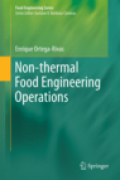
A number of food engineering operations, in which heat is not used as a preserving factor, have been employed and are applied for preparation (cleaning, sorting, etc.), conversion (milling, agglomeration, etc.) or preservation (irradiation, high pressure processing, pulsed electric fields, etc.) purposes in the food industry. This book presents a comprehensive treatise of all normally used food engineering operations that are carried out at room (or ambient) conditions, whether they are aimed at producing microbiologically safe foods with minimum alteration to sensory and nutritive properties, or they constitute routine preparative or transformation operations. The book is written for both undergraduate and graduate students, as well as for educators and practicing food process engineers. It reviews theoretical concepts, analyzes their use in operating variables of equipment, and discusses in detail different applicationsin diverse food processes. Fills the gap in the topic of alternative or nonconventional food processing technologies. Focus on non-thermal food engineering, not on all food processing technologies. Includes relevant non-thermal food engineering operations. INDICE: Part I. Introductory Aspects. 1. Classification of Food Processingand Preservation Operations. 2. Common Preliminary Operations: Cleaning, Sorting, Grading. 3. Materials Handling in the Food Industry. 4. Size Reduction. 5. Size Enlargement. 6. Mixing and Emulsification. 7. Separation Techniques forSolids and Suspensions. 8. Membrane Separations. 9. Electromagnetic Radiation: Ultraviolet Energy Treatment. 10. Ionizing Radiation: Irradiation. 11. Ultrasound in Food Preservation. 12. Pulsed Light Technology. 13. High-Voltage Pulsed Electric Fields. 14. Ultra-High Hydrostatic Pressure. 15. Protective and Preserving Food Packaging. 16. Other Methods.
- ISBN: 978-1-4614-2037-8
- Editorial: Springer US
- Encuadernacion: Cartoné
- Páginas: 355
- Fecha Publicación: 28/03/2012
- Nº Volúmenes: 1
- Idioma: Inglés
